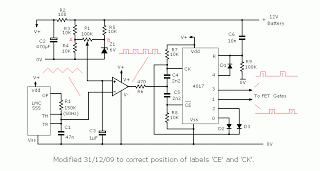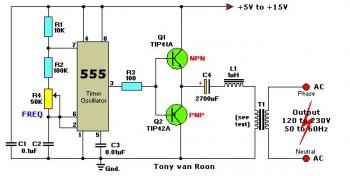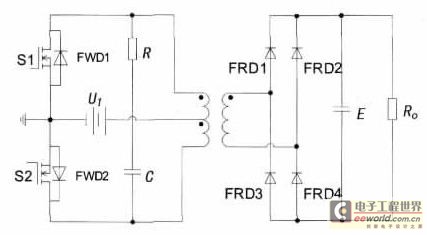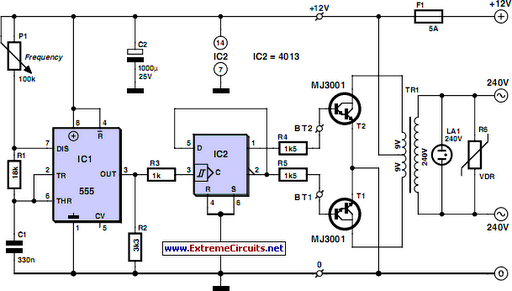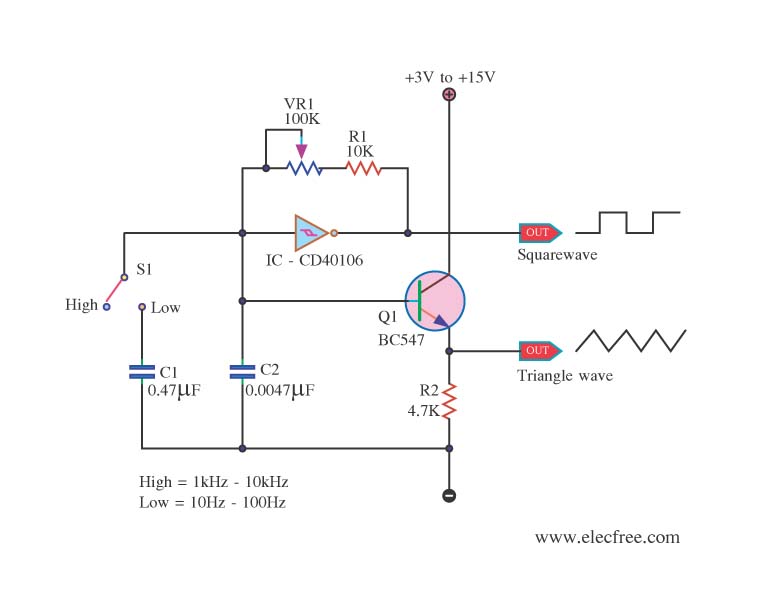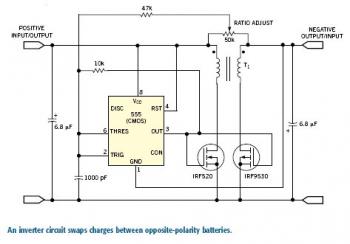
DC-AC inverter targets electroluminescent applications

This article describes a DC-AC inverter circuit that generates the high-voltage AC signal required to drive an electroluminescent (EL) panel. It is based on the Sipex SP4425 EL lamp-driver IC.
The DC-AC inverter circuit utilizes the Sipex SP4425 integrated circuit, which is specifically designed to power electroluminescent panels. The SP4425 is capable of converting a low-voltage DC input into a high-voltage AC output, which is essential for the operation of EL panels. The inverter circuit typically consists of several key components, including the SP4425 IC, capacitors, resistors, and inductors, which work together to create the necessary oscillation and voltage amplification.
The SP4425 operates by generating a square wave signal that is fed into a transformer or an inductor. This signal is then transformed into a higher voltage AC signal suitable for driving the EL panel. The circuit configuration may include feedback mechanisms to stabilize the output voltage and ensure consistent performance under varying load conditions.
Capacitors play a crucial role in filtering and smoothing the output AC signal, while resistors may be used to set the operating frequency and ensure proper biasing of the circuit. Inductors are essential for energy storage and transferring energy from the input to the output in a controlled manner.
Overall, this inverter circuit is designed for efficiency and reliability, enabling the effective operation of EL panels in various applications such as backlighting, signage, and decorative lighting. The use of the Sipex SP4425 IC simplifies the design process, allowing for compact and cost-effective solutions in electroluminescent lighting systems.This article describes a dc-ac inverter circuit that generates the high-voltage ac signal required to drive an electroluminescent (EL) panel. It`s based on the Sipex SP4425 EL lamp-driver IC 🔗 External reference
The DC-AC inverter circuit utilizes the Sipex SP4425 integrated circuit, which is specifically designed to power electroluminescent panels. The SP4425 is capable of converting a low-voltage DC input into a high-voltage AC output, which is essential for the operation of EL panels. The inverter circuit typically consists of several key components, including the SP4425 IC, capacitors, resistors, and inductors, which work together to create the necessary oscillation and voltage amplification.
The SP4425 operates by generating a square wave signal that is fed into a transformer or an inductor. This signal is then transformed into a higher voltage AC signal suitable for driving the EL panel. The circuit configuration may include feedback mechanisms to stabilize the output voltage and ensure consistent performance under varying load conditions.
Capacitors play a crucial role in filtering and smoothing the output AC signal, while resistors may be used to set the operating frequency and ensure proper biasing of the circuit. Inductors are essential for energy storage and transferring energy from the input to the output in a controlled manner.
Overall, this inverter circuit is designed for efficiency and reliability, enabling the effective operation of EL panels in various applications such as backlighting, signage, and decorative lighting. The use of the Sipex SP4425 IC simplifies the design process, allowing for compact and cost-effective solutions in electroluminescent lighting systems.This article describes a dc-ac inverter circuit that generates the high-voltage ac signal required to drive an electroluminescent (EL) panel. It`s based on the Sipex SP4425 EL lamp-driver IC 🔗 External reference
